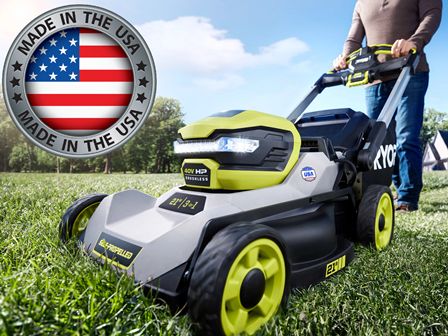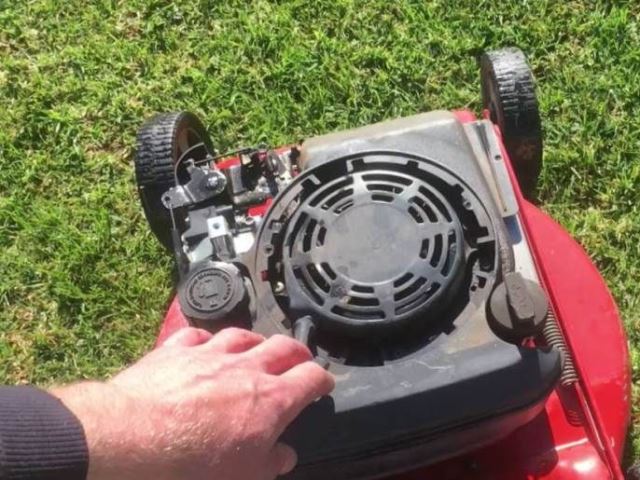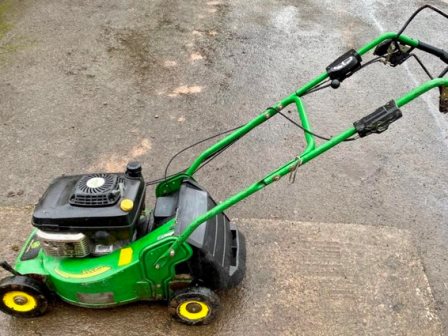Self-propelled lawn mowers offer a convenient and efficient way to maintain a well-manicured lawn, but they are not without their problems. Over time, various issues can arise, affecting performance and reliability.
Understanding these common problems and knowing how to address them can ensure that your mower operates smoothly and effectively for years to come.

How to fix self propelled lawn mower?
Self-propelled lawn mowers can face various issues over time. Here are some common problems and troubleshooting tips:
1. Mower Won’t Start
- Check the Fuel: Ensure there is enough fuel in the tank and that it’s fresh. Stale fuel can cause starting problems.
- Spark Plug: Inspect the spark plug for wear or damage and replace it if necessary. Also, check the connection.
- Air Filter: A clogged air filter can prevent the engine from starting. Clean or replace the air filter.
- Battery: For electric start mowers, check the battery charge and connections.
2. Mower Starts but Doesn’t Stay Running
- Carburetor Issues: Clean the carburetor and ensure it’s functioning correctly. Gummed-up carburetors can cause stalling.
- Fuel Line: Check for any blockages or leaks in the fuel line.
- Choke: Ensure the choke is working correctly and not stuck.
3. Poor Cutting Performance
- Blade Sharpening: Dull blades can tear grass instead of cutting it. Sharpen or replace the blades as needed.
- Deck Cleanliness: Clean the underside of the mower deck to remove grass clippings and debris that can obstruct cutting.
- Cutting Height: Adjust the cutting height to ensure the mower is cutting the grass efficiently.
4. Self-Propelled Function Not Working
- Drive Belt: Check the drive belt for wear or damage and replace it if necessary.
- Transmission: Inspect the transmission for issues. Some models have adjustable tension on the drive belt.
- Drive Cable: Ensure the drive cable is properly connected and not damaged.
5. Mower is Hard to Push
- Wheel Adjustment: Make sure the wheels are properly adjusted and that the height settings are even.
- Wheel Condition: Inspect the wheels for damage or excessive wear and replace them if needed.
- Lubrication: Lubricate the wheel axles and other moving parts as recommended by the manufacturer.
6. Unusual Noises or Vibrations
- Loose Parts: Check for any loose screws, bolts, or other components.
- Engine Mounting: Ensure the engine is securely mounted to the frame.
- Debris: Look for any debris caught in the blades or drive system.
7. Smoking Engine
- Oil Level: Check the oil level and ensure it’s at the correct level. Overfilled or low oil can cause smoking.
- Air Filter: A dirty air filter can cause the engine to smoke.
- Fuel Quality: Ensure you are using the correct fuel type and that it’s fresh.
Maintenance tips for self-propelled lawn mowers
Maintaining a self-propelled lawn mower is essential to ensure its longevity and optimal performance. Regular maintenance helps prevent common problems, enhances cutting efficiency, and keeps the mower running smoothly. Here are some comprehensive maintenance tips for self-propelled lawn mowers:
Regular Cleaning
- Clean the Mower Deck:
- After each use, clean the underside of the mower deck to remove grass clippings, dirt, and debris. This prevents buildup that can obstruct the blades and affect cutting performance.
- Use a garden hose to rinse the deck, but avoid spraying water directly on the engine.
- Clean the Exterior:
- Wipe down the mower’s exterior to remove dirt and grass clippings. Keeping the mower clean prevents rust and maintains its appearance.
Engine Maintenance
- Change the Oil:
- Regularly check the oil level and change the oil according to the manufacturer’s recommendations. Fresh oil ensures the engine runs smoothly and reduces wear.
- Refer to the owner’s manual for the correct type and amount of oil.
- Replace the Air Filter:
- Inspect the air filter regularly and replace it if it is dirty or clogged. A clean air filter allows the engine to breathe properly, improving performance and fuel efficiency.
- Spark Plug Maintenance:
- Check the spark plug for wear or deposits. Clean or replace the spark plug as needed to ensure reliable starting and efficient combustion.
Blade Care
- Sharpen the Blades:
- Dull blades tear the grass, leading to an uneven cut and stressing the lawn. Sharpen the blades at least once a season or more frequently if needed.
- Always disconnect the spark plug before removing the blade for sharpening to prevent accidental starts.
- Balance the Blades:
- Ensure the blades are balanced after sharpening to prevent excessive vibrations that can damage the mower and affect the cut quality.
Fuel System Maintenance
- Use Fresh Fuel:
- Always use fresh, clean fuel. Stale fuel can cause starting problems and poor engine performance.
- Consider using a fuel stabilizer if you store fuel for extended periods.
- Inspect the Fuel Line:
- Check the fuel line for cracks, leaks, or blockages. Replace damaged fuel lines to ensure proper fuel flow to the engine.
Drive System Maintenance
- Check the Drive Belt:
- Inspect the drive belt for wear, cracks, or damage. Replace the belt if it shows signs of wear to maintain the self-propelled function.
- Lubricate Moving Parts:
- Lubricate the wheel axles, drive system, and other moving parts according to the manufacturer’s recommendations. Proper lubrication reduces friction and wear.
Wheel and Height Adjustment
- Inspect the Wheels:
- Check the wheels for damage or excessive wear. Replace worn wheels to ensure smooth operation and maneuverability.
- Adjust the Cutting Height:
- Regularly adjust the cutting height to match the lawn’s needs. Proper height adjustment ensures an even cut and promotes healthy grass growth.
Storage Tips
- Proper Storage:
- Store the mower in a dry, sheltered place to protect it from the elements. Exposure to moisture can cause rust and other damage.
- Winterizing the Mower:
- If you store the mower for the winter, drain the fuel tank or add a fuel stabilizer. Clean the mower thoroughly and perform any necessary maintenance before storing it.
Regular Inspections
- Check for Loose Parts:
- Regularly inspect the mower for loose screws, bolts, and other components. Tighten any loose parts to prevent damage and ensure safe operation.
- Inspect Safety Features:
- Ensure that all safety features, such as the blade brake and safety switches, are functioning correctly. Replace or repair faulty safety features immediately.
Professional Servicing
- Scheduled Servicing:
- Consider having your mower professionally serviced at least once a year. A professional can perform thorough maintenance and address any issues you might have missed.
By following these maintenance tips, you can keep your self-propelled lawn mower in top condition, ensuring efficient operation and extending its lifespan. Regular maintenance not only prevents common problems but also enhances the mower’s performance, providing you with a beautifully manicured lawn season after season.



